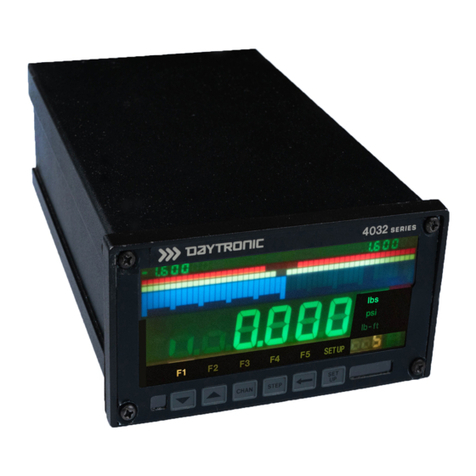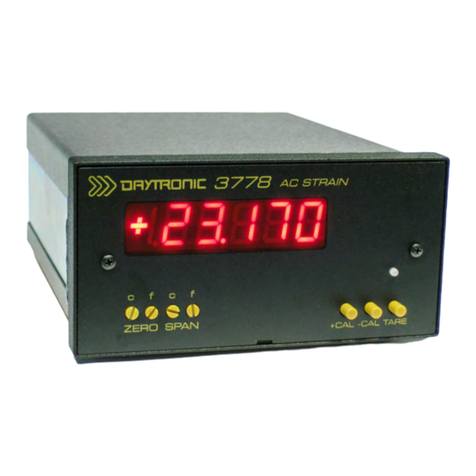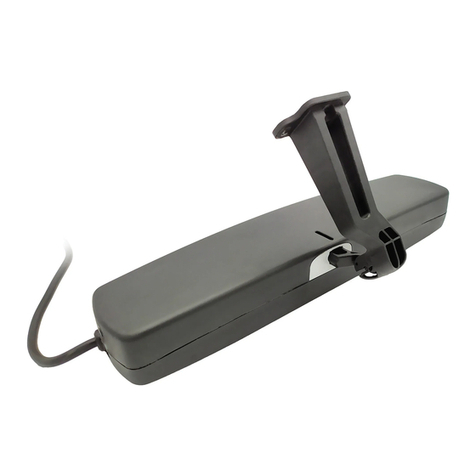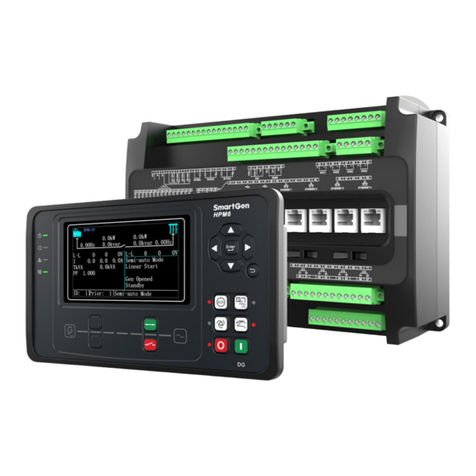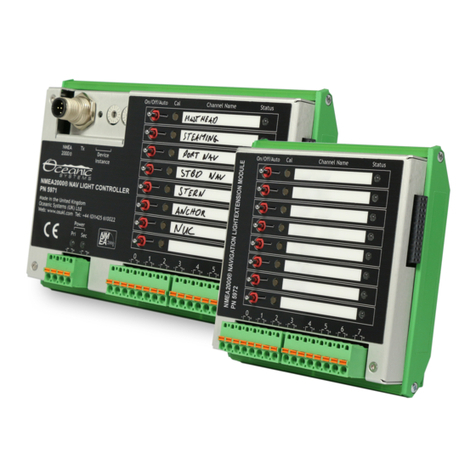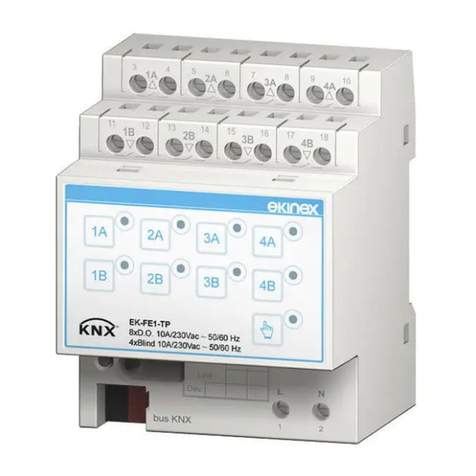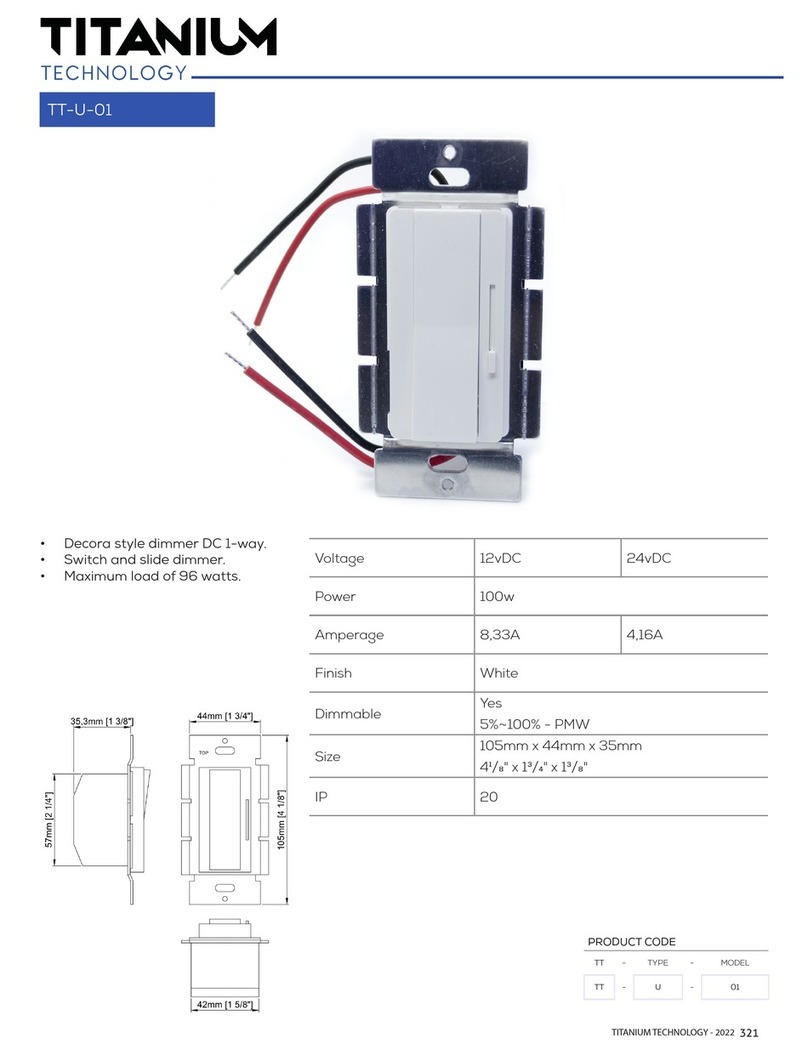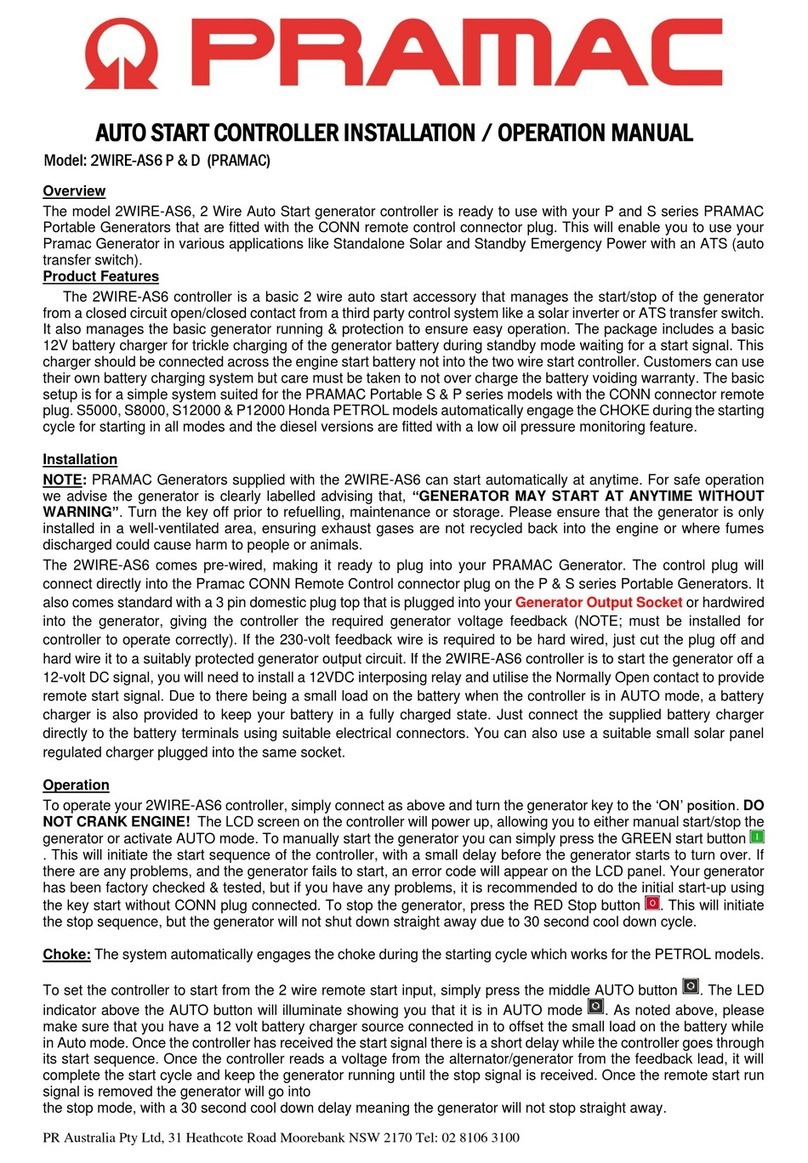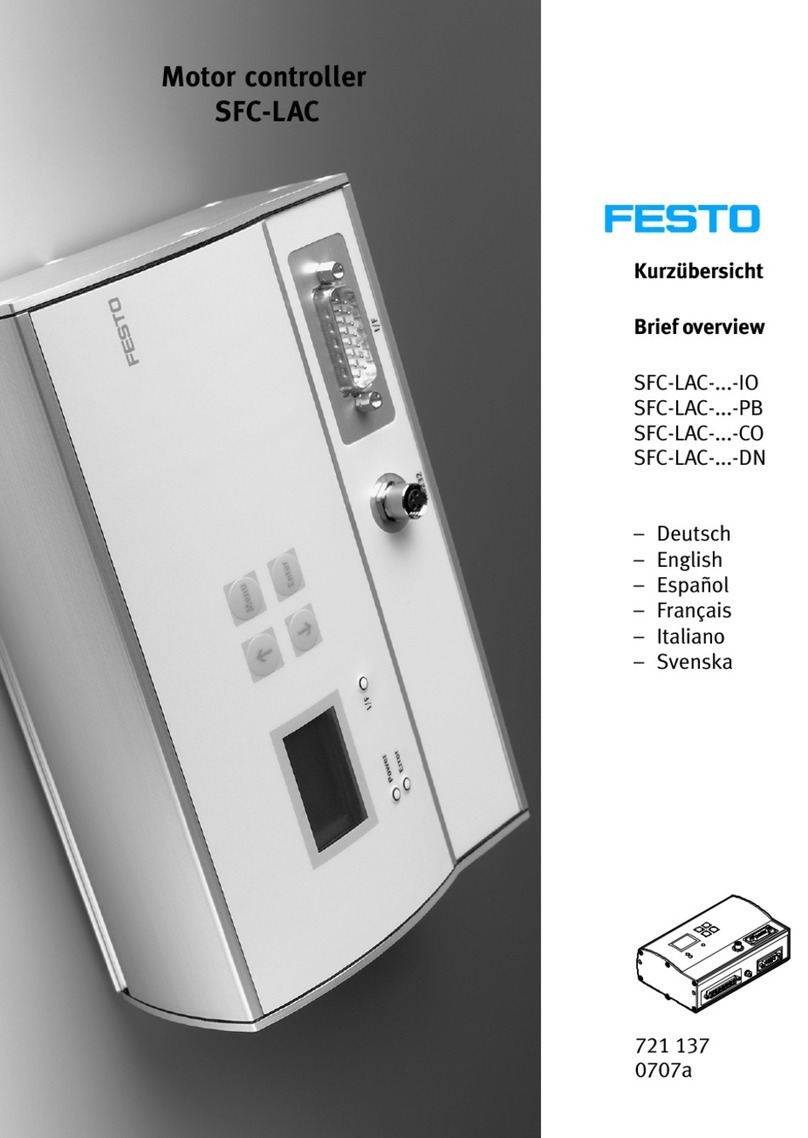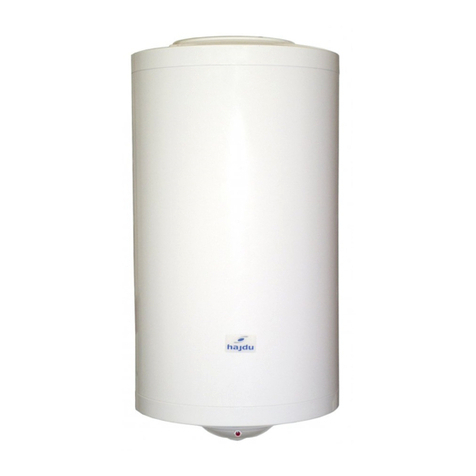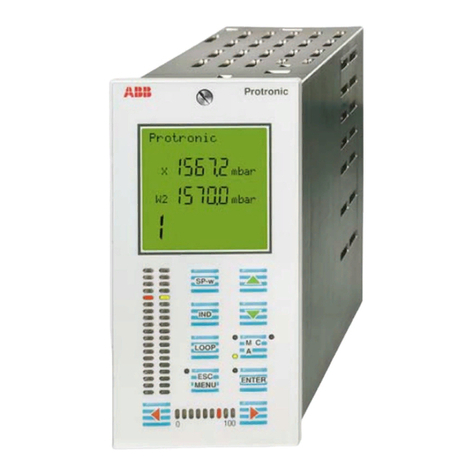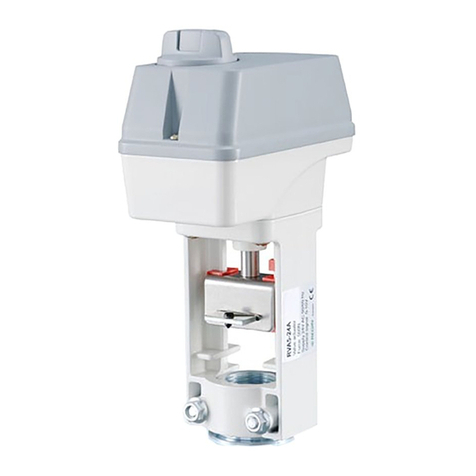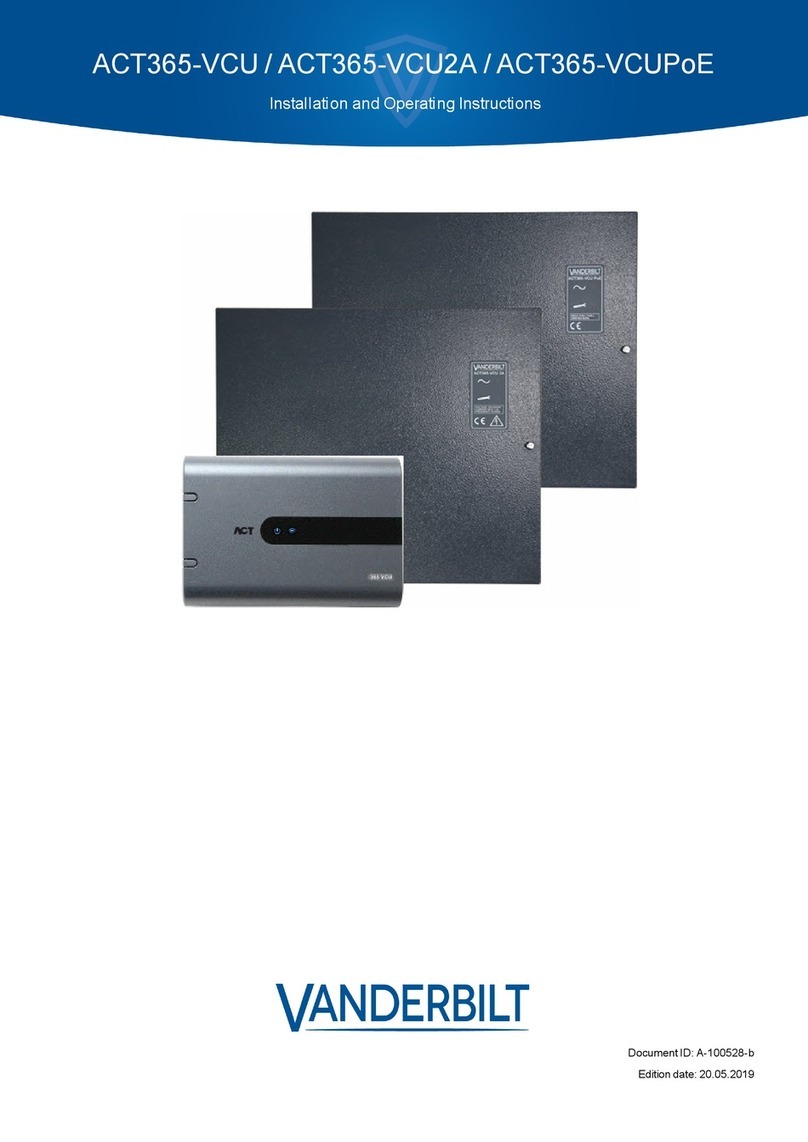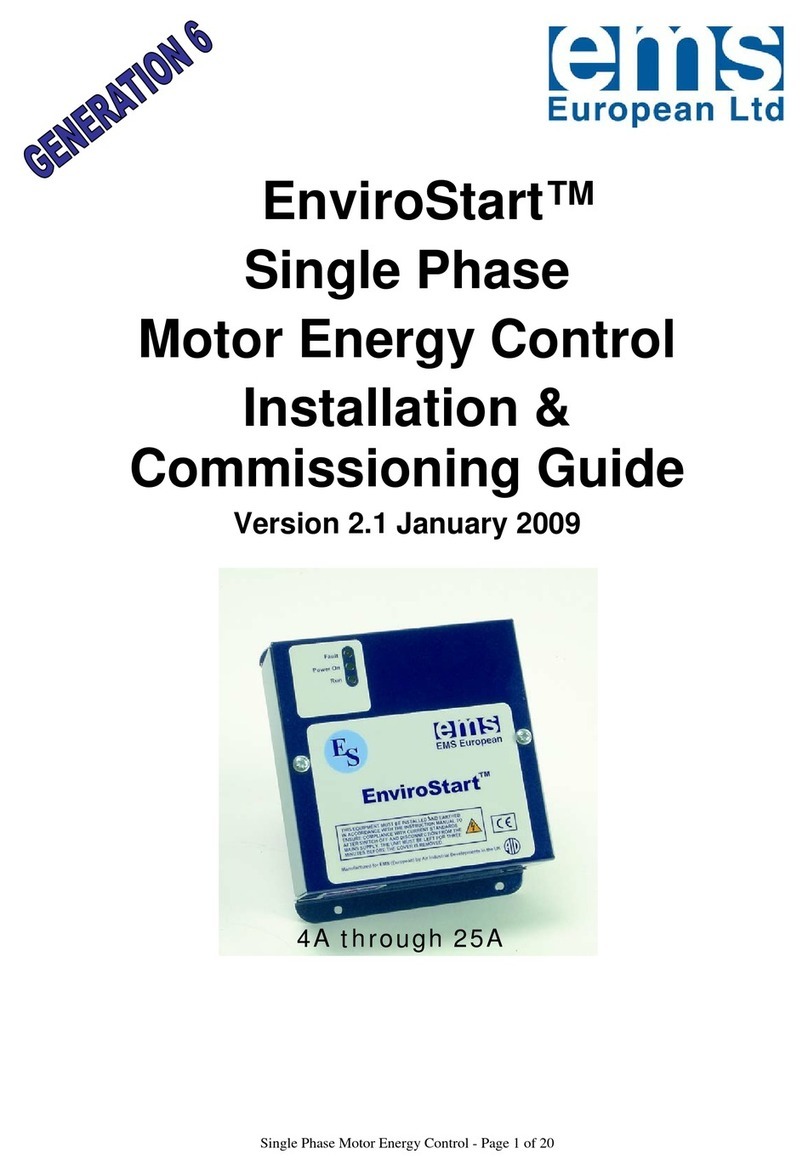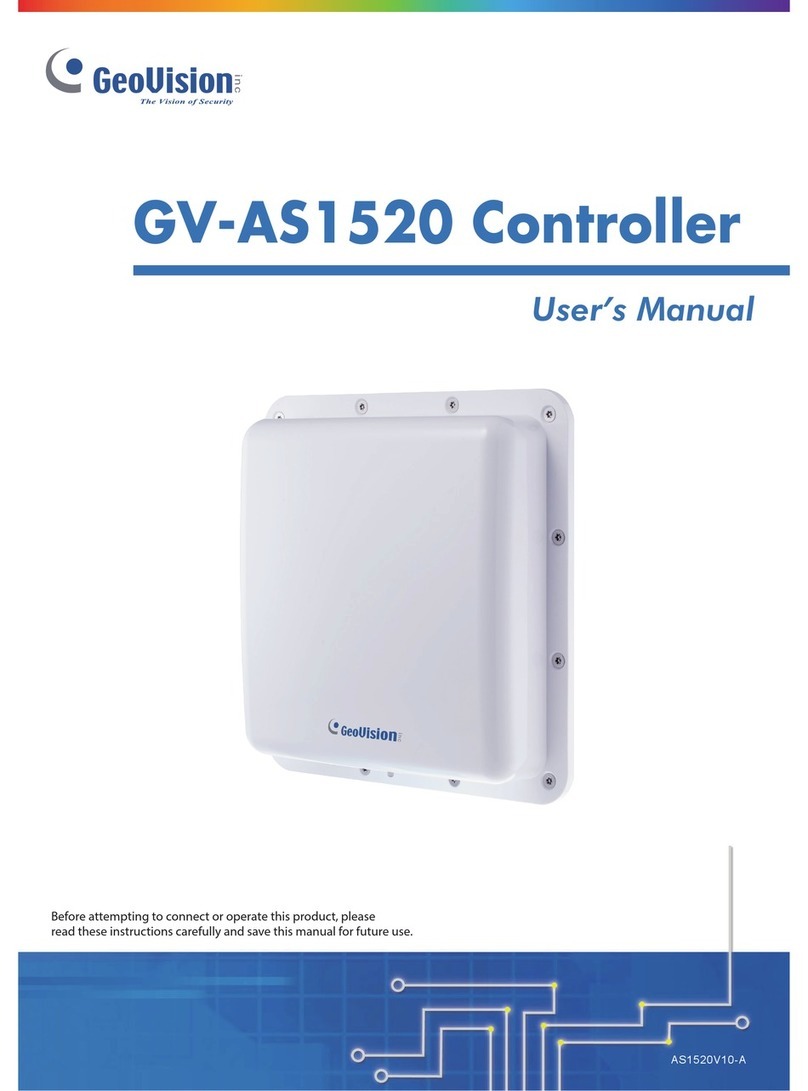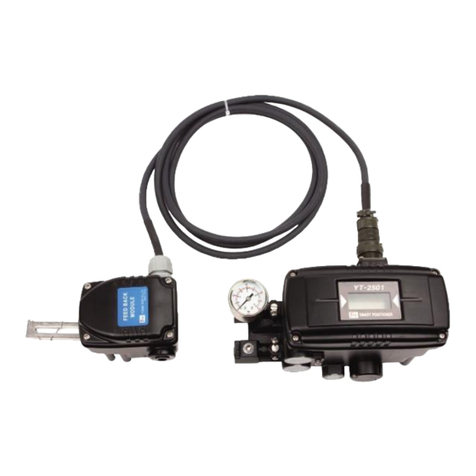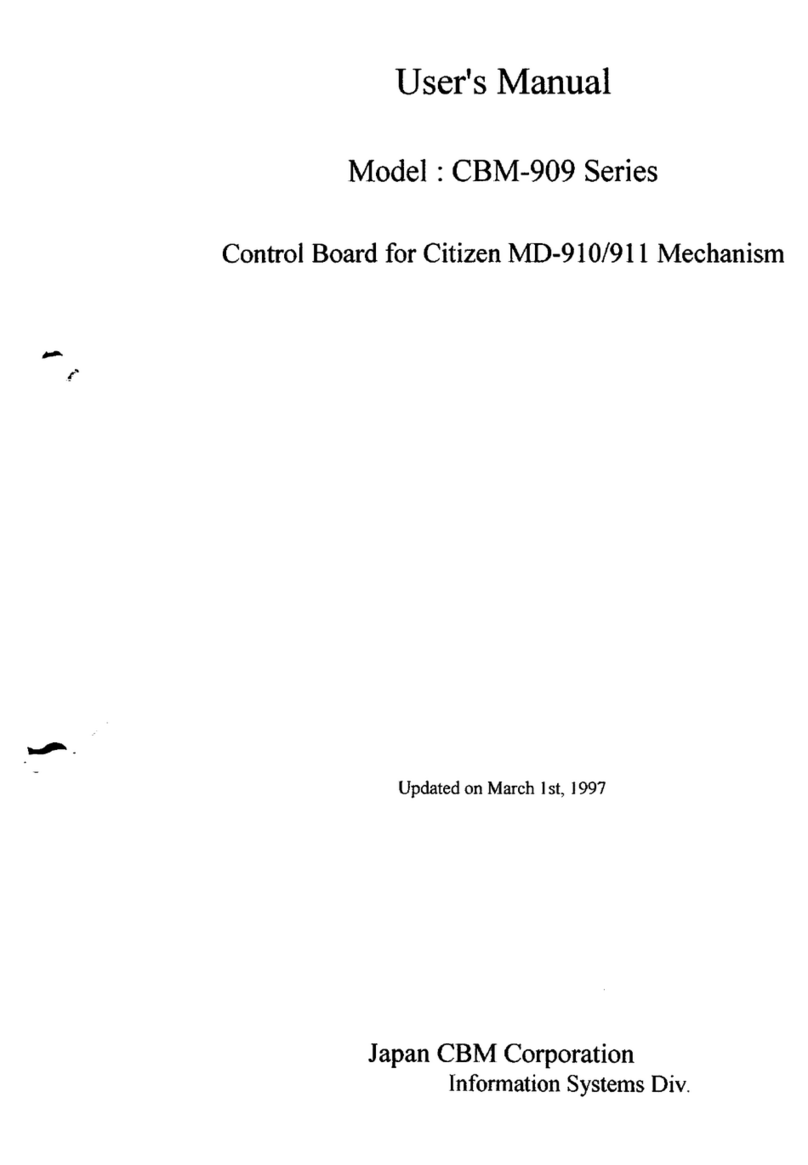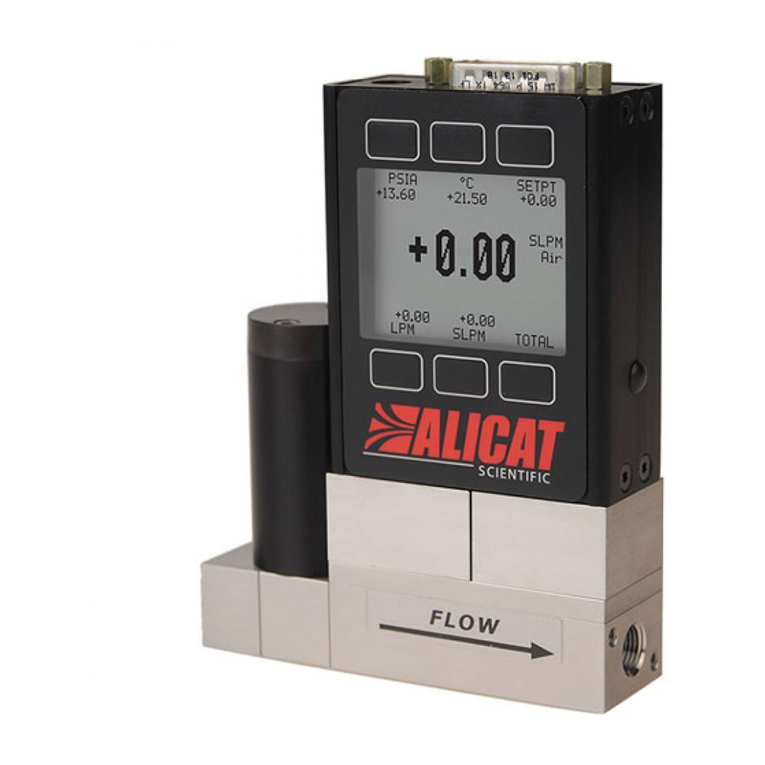DayTronic 3700 Series User manual

MODEL
3760
DC VOLTAGE CONDITIONER
SB.1.1
INSTRUCTION MANUAL
3700
Instrument Series

WARNING
Death, serious injury, or fire hazard could result from improper connection of this instrument. Read and understand this
manual before connecting this instrument. Follow all installation and operating instructions while using this instrument.
Connection of this instrument must be performed in compliance with the National Electrical Code (ANSI/NFPA 70-2014) of
USA and any additional safety requirements applicable to your installation.
Installation, operation, and maintenance of this instrument must be performed by qualified personnel only. The National
Electrical Code defines a qualified person as “one who has demonstrated the skills and knowledge related to the construction
and operation of the electrical equipment and installations, and who has received safety training on the hazards involved.”
Qualified personnel who work on or near exposed energized electrical conductors must follow applicable safety related
work practices and procedures including appropriate personal protective equipment in compliance with the Standard for
Electrical Safety Requirements for Employee Workplaces (ANSI/NFPA 70E-2012) of USA and any additional workplace safety
requirements applicable to your installation.
ADVERTENCIA
Una conexión incorrecta de este instrumento puede producir la muerte, lesiones graves y riesgo de incendio. Lea y entienda
este manual antes de conectar. Observe todas las instrucciones de instalación y operación durante el uso de este
instrumento.
La conexión de este instrumento a un sistema eléctrico se debe realizar en conformidad con el Código Eléctrico Nacional
(ANSI/NFPA 70-2014) de los E.E.U.U., además de cualquier otra norma de seguridad correspondiente a su
establecimiento.
La instalación, operación y mantenimiento de este instrumento debe ser realizada por personal calificado solamente. El
Código Eléctrico Nacional define a una persona calificada como "una que esté familiarizada con la construcción y operación del
equipo y con los riesgos involucrados."
El personal cualificado que trabaja encendido o acerca a los conductores eléctricos energizados expuestos debe seguir
prácticas y procedimientos relacionados seguridad aplicable del trabajo incluyendo el equipo protector personal apropiado
en conformidad con el estándar para los requisitos de seguridad eléctricos para los lugares de trabajo del empleado (ANSI/
NFPA 70E-2012) de los E.E.U.U. y cualquier requisito de seguridad adicional del lugar de trabajo aplicable a su instalación.
AVERTISSEMENT
Si l'instrument est mal connecté, la mort, des blessures graves, ou un danger d'incendie peuvent s'en suivre. Lisez
attentivement ce manuel avant de connecter l'instrument. Lorsque vous utilisez l'instrument, suivez toutes les
instructions d'installation et de service.
Cet instrument doit être connecté conformément au National Electrical Code (ANSI/NFPA 70-2014) des Etats-Unis et à
toutes les exigences de sécurité applicables à votre installation.
Cet instrument doit être installé, utilisé et entretenu uniquement par un personnel qualifié. Selon le National Electrical
Code, une personne est qualifiée si "elle connaît bien la construction et l'utilisation de l'équipement, ainsi que les dangers
que cela implique".
Le personnel qualifié qui travaillent dessus ou s'approchent des conducteurs électriques activés exposés doit suivre des
pratiques en matière et des procédures reliées par sûreté applicable de travail comprenant le matériel de protection
personnel approprié conformément à la norme pour des conditions de sûreté électriques pour les lieux de travail des
employés (ANSI/NFPA 70E-2012) des Etats-Unis et toutes les conditions de sûreté additionnelles de lieu de travail
applicables à votre installation.
Page 1

WARNUNG
Der falsche Anschluß dieses Gerätes kann Tod, schwere Verletzungen oder Feuer verursachen. Bevor Sie dieses Instrument
anschließen, müssen Sie die Anleitung lesen und verstanden haben. Bei der Verwendung dieses Instruments müssen alle
Installation- und Betriebsanweisungen beachtet werden.
Der Anschluß dieses Instruments muß in Übereinstimmung mit den nationalen Bestimmungen für Elektrizität (ANSI/NFPA
70- 2014) der Vereinigten Staaten, sowie allen weiteren, in Ihrem Fall anwendbaren Sicherheitsbestimmungen, vorgenommen
werden.
Installation, Betrieb und Wartung dieses Instruments dürfen nur von Fachpersonal durchgeführt werden. In dem nationalen
Bestimmungen für Elektrizität wird ein Fachmann als eine Person bezeichnet, welche "mit der Bauweise und dem Betrieb des
Gerätes sowie den dazugehörigen Gefahren vertraut ist."
Qualifiziertes Personal, das an bearbeiten oder herausgestellte angezogene elektrische Leiter sich nähern, muß anwendbare
Sicherheit bezogener Arbeit Praxis und Verfahren einschließlich passende persönliche schützende Ausrüstung gemäß dem
Standard für elektrische Sicherheitsauflagen für Angestellt-Arbeitsplätze (ANSI/NFPA 70E-2012) der Vereinigten Staaten
und alle zusätzlichen Arbeitsplatzsicherheitsauflagen folgen, die auf Ihre Installation anwendbar sind.
Safety Precautions
The following safety precautions must be followed whenever any type of voltage or current connection is being made to the
instrument.
oBefore connecting to electric circuits or pulse initiating equipment, open their related breakers or disconnects. It is
recommended NOT TO install any connection of the instrument on live power lines. Only Qualified Service personnel that
have demonstrated the abilities and received the proper safety training are capable of connecting to live circuits.
oConnections must be made to the instrument first, then connect to the circuit to be monitored.
oWear proper personal protective equipment, including safety glasses and insulated gloves when making connections to
power circuits.
oHands, shoes and floor must be dry when making any connection to a power line.
oBefore each use, inspect all cables for breaks or cracks in the insulation. Replace immediately if defective.
oIf the equipment is used in a manner not specified in this user’s guide, the protection provided by the equipment may be
impaired.
Page 2

Medidas de seguridad
Las medidas de seguridad siguientes deberán observarse cuando se realice cualquier tipo de conexión al instrumento.
οCuando se haga conexiones a circuitos eléctricos o a equipo de activación por pulso, deberá abrirse sus respectivas cajas
de seguridad. NO deberá hacerse ninguna conexión del instrumento en líneas eléctricas bajo tensión.
οLas conexiones deberán hacerse primero al instrumento y, luego, al circuito a ser monitorizado.
οAl hacer conexiones a circuitos eléctricos, deberá utilizar anteojos y guantes protectores.
οSus manos, zapatos y el piso deberán estar secos en todo momento en que se haga una conexión a un cable eléctrico.
οVerifique que la unidad esté DESACTIVADA antes de conectar sondas en el panel posterior.
οPrevio a cada uso, deberá verificarse que los cables no estén rotos y que el material aislante no tenga rajaduras.
Reemplace de inmediato cualquier parte defectuosa.
Mesures de Sécurité
Les mesures de sécurité suivantes doivent être prises chaque fois qu’un type de connexion quelconque est effectué
sur l’instrument.
οOuvrir les disjoncteurs correspondants lors d’une connexion à des circuits électriques ou à des équipement de génération
d’impulsions. NE PAS effectuer de connexion d’instrument sur des lignes électriques sous tension.
οUne fois toutes les connexions de l’instrument effectuées, connecter au circuit à contrôler.
οPorter des lunettes de protection et des gants isolants pour effectuer des connexions aux circuits électriques.
οS’assurer que les mains, les chaussures et le sol soient secs lors de connexions à une ligne électrique.
οS’assurer que l’unité est ÉTEINTE avant de connecter les sondes au panneau arrière.
οInspecter tous les câbles, avant chaque utilisation, pour s’assurer que les isolants ne sont pas coupés ou fendus.
Remplacer immédiatement tous les équipements défectueux.
Page 3

Sicherheitsvorkehrungen
Die folgenden Sicherheitsvorkehrungen sind immer dann zu befolgen, wenn eine Verbindung zum Instrument hergestellt wird.
οÖffnen Sie beim Anschluß an elektrische Stromkreise oder Impulsauslösungseinrichtungen die entsprechenden
Unterbrecher. Es dürfen KEINE Anschlüsse an das Instrument unter stromführenden Spannungsleitungen montiert
werden.
οDie Verbindungen müssen zuerst am Instrument und danach an der zu überwachenden Schaltung hergestellt werden.
οTragen Sie Schutzbrillen und Isolierhandschuhe, wenn Sie Anschlüsse an den Stromkreisen vornehmen.
οHände, Schuhe und Fußboden müssen trocken sein, wenn Sie Anschlüsse an den Stromkreisen durchführen.
οStellen Sie sicher, daß das Gerät AUSgeschaltet ist, bevor Sie an der rückwärtigen Konsole Meßfühler anschließen.
οPrüfen Sie vor jedem Gebrauch alle Kabel auf Bruchstellen und Risse in der Isolierung. Wechseln Sie schadhafte Kabel
sofort aus.
Standard Accessories
Standard
accessories The following table lists the 3700 standard accessories.
Page 4
Description Part Number
*US Power Cord USSTDCORD (900744)
*European Power Cord EUROSTDCORD (115369-G1)
*United Kingdom Power Cord UKSTDCORD (115368-G2)
*Australian Power Cord AUSTDCORD (901347)
3760 Manual 92362.00
*User specified, one standard only.
3760 Quick Reference Guide 92367.00
5 Pin connector, analog signals
8 Pin connector, transducer
10 Pin connector, logic
25657-LF
25658-LF
25606.00
Desk top feet (4ea.) 35058.00

M
ODEL
3760
DC VOLT & 4-20mA PANEL METER
3760
1.A.0.3760
1
G
ENERAL
D
ESCRIPTION AND
S
PECIFICATIONS
The Model 3760 is a single-channel panel instrument for DC Voltage and 4-20mA sensors;
intended for applications involving single ended or differential DC Voltage signals with
ratings between 50 mV to 200.0 Vdc input full scale or 4-20mA inputs. The 3760 will
supply excitation, conditioning and provide a calibrated Engineering Unit's display and
analog output signals for the measurement of pressure, displacement, speed, load and other
parameters associated with DC based sensors. The 3760 is front panel configurable with
user selectable wide gain, zero, symmetry, and selectable analog output of voltage and
current signals. Display is user configured and independently adjustable for engineering unit
scaling up to ± 199950 independent of the analog full scale signal.
The Model 3760 can be calibrated by the “two-point (dead-weight)” process involving
known “zero” and “full scale” input parameters. A convenient “RCAL” front panel push
button or rear panel connection is available for calibration verification.
FRONT PANEL VIEW OF 3760 CONTROLS (Front Display Cover Removed)
1 2 3 4 5 6 7
CF
CCFF
1 . X . X . X . X 0
FINE ADJUST
ZERO SPAN 1.X.X.X.X 0
ZERO SPAN
WIDE ADJUST
5000
10000
20000
SYM
DISPLAY SPAN
TARE
RCAL
1 2 3 4 5 6 7
ANALOG CTRL
FINE ADJUST
COARSE ZERO
FINE ZERO
COARSE SPAN
FINE SPAN
WIDE ADJUST
ZERO
SPAN
DISPLAY CONFIGURATION
Sw 1,2,3,4 DECIMAL POINT PLACEMENT
Sw 5 DUMMY ZERO
Sw 6 & 7 DISPLAY RESOLUTION
RCAL Remote Calibration
TARE
ANALOG CONTROL SETTINGS
1 – VOLTAGE OUTPUT – 5.0 or 10.0 VDC
2 - CURRENT OUTPUT – 4-20 mA
3 - ANALOG FILTER – 20 / 200 Hz
4 - ANALOG FILTER – 20 / 2 Hz
5 - CURRENT INPUT – 4-20 / 4-12-20
6 - VDC INPUT RANGE SELECT
7 - VDC INPUT RANGE SELECT
DISPLAY SPAN
COARSE
FINE
SYMMETRY
OFF
Page 5

M
ODEL
3760
DC VOLT & 4-20mA PANEL METER
3760
SPECIFICATIONS
Measurement Range: Adjustable; 0.050 mV to 200 VDC; or 4-20 / 4-12-20 mA nominal full-scale.
Transducer Types: DC Voltage or mA Current out (potentiometer, DC to DC LVDT)
Excitation: ± 12.0 Vdc (24 Vdc), up to 50 mA.
Power Supply: Voltage 90 - 250 VAC, 47 -63 Hz
Amplifier
Normal - Mode Range: ±5 V RMS operating; ±28 V without instrument damage
Input Impedance: Differential 200 kΩ
Offset: vs. Temperature: ±30 ppm µV/°C; vs. Time: ±10 ppm/month
Gain Accuracy: Limited only by calibration accuracy
Gain Stability: vs. Temperature: ±30 ppm/°C; vs. Time: ±10 ppm/month
Linearity: better than ± 0.03% of full scale
Filter: 3-pole modified Butterworth; 3 dB down at 2 Hz, 20 Hz or 200 Hz; selectable.
Fast output always enabled, 5 KHz response (J3 Pin 3).
Common Mode:
Range C-M Range
(Vf.s.) (+/- V)
0.050 - 0.400 5
0.400 - 3.200 40
3.200 - 25.00 200
25.0 0 - 200.0 200
Step-Response Settling Times for the 3760 (in milliseconds)
3db Frequency To within 1% within .1% within .02%
Fast Output 5000 Hz 0.14 0.10 0.08
Selectable Output 200 Hz 3.7 5.0 5.6
20 Hz 37 50 56
2 Hz 370 500 560
1.a
P
ANEL
M
OUNTING
You can easily mount the instrument in your own precut panel. Cutout dimensions for a
panel-mounted unit are standard
DIN
; panel thickness should not exceed 6 mm (0.24
in).Simply unscrew the two rear-panel CLAMP SCREWS and slide the CLAMP
SLIDES rearwards out of their grooves (THE FRONT BEZEL NEED NOT BE REMOVED).
Insert the unit through the panel cutout, from the front of the panel (if the unit has rubber
feet, these will have to be removed). Then reinstall the CLAMP SLIDES, and tighten the
CLAMP SCREWS until the instrument is securely mounted.
Page 6
Consumption 10 Watts
Physical Parameters: 5. 68” W x 2. 84” H x 7. 06” D; weight - 3. 25 Lbs.
Analog Output: selectable; ± 5, ±1 0 VDC, 4 -20 mA or 4 -12 -20 mA (20 % over -range on voltage outputs only)
Operating Temperature: 0 to +55 Degrees C, 5 to 95% relative humidity, non-condensing
Altitude: 2000m (6560 ft) maximum
Installation Category: Installation Category II, Pollution Degree 2

M
ODEL
3760
DC VOLT & 4-20mA PANEL METER
2
C
ONNECTIONS
The Model 3760 I/O CONNECTIONS are via removable screw terminals which will accept wire sizes
from AWG 12 to 26. NOTE:The recommended transducer cabling would be twisted pair,
individually shielded - wired as indicated (Fig. 6). Table 1 denotes screw terminal assignments
Rear Panel Connections
HOLD
TARE
LOGIC COM
TARE ENABLE
EXCITATION
EXCITATION
mA ENB
SIGNAL
SIGNAL
EXC COMMON
SHIELD
VDC COM
V OUT SEL
V OUT FAST
4-20 mA COM
4-20 mA OUT
+
_
_
+
N/C
N/C
R CAL
3760
CM FAULT
N/C
N/C
mA
_
Table 1
Connector Screw Terminal Line
Number Terminal Label Function
J1 1 N/C
J1 2 N/C
J1 3 HOLD
J1 4 TARE
J1 5 TARE ENABLE
J1 6 LOGIC COM
J1 7 R CAL
J1 8 N/C
J1 9 CM FAULT
J1 10 N/C
No connection
No connection
Input Analog Hold command
Input Analog TARE command
External TARE enable input
Logic Common
Remote Calibration Command
No connection
Common Mode Fault output
No connection
J2 1 + EXCITATION
J2 2 - EXCITATION
J2 3 mA ENABLE
J2 4 - mA
J2 5 + SIGNAL
J2 6 - SIGNAL
J2 7 EXC COMMON
J2 8 SHIELD
+ Excitation Power
- Excitation Power
Jumper Connection to Enable mA input
- Negative 4-20 mA Input Signal from sensor
+ Signal Input (VDC or mA)from sensor
- Signal Input from sensor
Excitation common
Case Shield for cable termination
J3 1 V OUT COM - Signal Output Voltage Common
J3 2 V OUT SEL + Signal Output Voltage – Filter Select
J3 3 V OUT FAST + Signal Output Voltage – 5 kHz Filter
J3 4 4-20 mA COM Current Output Common
J3 5 4-20 mA OUT Current Output Signal
Page 7

M
ODEL
3760
DC VOLT & 4-20mA PANEL METER
2
C
ONNECTIONS
J1 – RCAL Command Connections.
Connection is used to remotely activate the positive
calibration command from the rear panel. When the RCAL terminal is connected to LOGIC COM
via a switch or relay, the 3760 meter will generate 80% of the full scale value as configured.
Fig. 4
RCAL Command
Connections
J1 - RCAL Activation
Connections
Connecting LOG COMMON to the R CAL
terminals will activate an internal voltage
reference in place of the sensor’s signal for
simulated calibration & verification check of
the 3760 settings and input operation.
LOGIC COM
R CAL +
N/O
Switch
J2 - HOLD & TARE Connections.
Connection is used when external control of the "HOLD" and
"TARE" features of the unit are enabled and are controlled by an external switch, PLC or relay. The
LOG COM signal is used to activate the analog HOLD or Analog TARE (offset) to the meter's
display and analog output signals present on J3.
Fig. 5
J1 Logic Controls
HOLD IN Activates Analog HOLD when connected to LOGIC COMMON
TARE IN Activates Analog TARE when connected to LOGIC COMMON
TARE ENABLE Enables remote TARE and disables front panel TARE when connected to LOGIC COMMON
LOGIC COMMON Connection to enable rear panel features
COMMON MODE FAULT Logic Output. True when the input signal’s Common Mode exceeds specifications.
Push Button, Contact Relay,
Switch…..
LOGIC COM
HOLD
TARE
TARE ENABLE
CM FAULT
Page 8
Common Mode: Is the voltage level at which the input signal can be "floating" from earth common
which the 3760 can function properly. If this level is exceeeded, the "CMF" (terminal 9, J1) will go true
(to ground), giving the user a remote status of the Common-Mode condition of the 3760 unit.
Static condition of terminal 9 is TTL (+ 5 Vdc).

M
ODEL
3760
DC VOLT & 4-20mA PANEL METER
2
C
ONNECTIONS
Fig. 6 - Transducer Cabling – DC Voltage Input- J2 Connector
EXCITATION
EXCITATION
SIGNAL
SIGNAL
+
_
_
+
SHIELD
EXC COMMON
+ Power
- Power
+ Signal
_
DC Powered
Sensor
24 Vdc
DC – DC LVDT
DC Load / Pressure Sensors
Amplified Sensors
mA
mA ENB
EXCITATION
EXCITATION
SIGNAL
SIGNAL
+
_
_
+
SHIELD
EXC COMMON
Linear
Potentiometer
Sensor
Linear Potentiometers
Zero Centered for
Bi-Directional output
_ mA
EXCITATION
EXCITATION
SIGNAL
SIGNAL
+
_
_
+
SHIELD
EXC COMMON
Linear
Potentiometer
Sensor
Linear Potentiometer
With Uni-Directional output
mA
_
EXCITATION
EXCITATION
SIGNAL
SIGNAL
+
_
_
+
SHIELD
EXC COMMON
mA
_
Linear
Sensor
Linear Transducer
With 4-20mA output
+ Power
- Power
- Signal
+ Signal
Page 9
mA ENB
mA ENB
mA ENB
WARNING
Qualified personnel who work on or near exposed energized electrical conductors must follow applicable safety
related work practices and procedures including appropriate personal protective equipment in compliance with the
Standard for Electrical Safety Requirements for Employee Workplaces (ANSI/NFPA 70E-2012) of USA and any
additional workplace safety requirements applicable to your installation.

M
ODEL
3760
DC VOLT & 4-20mA PANEL METER
2
C
ONNECTIONS
J3 - Analog Connections Provides analog outputs from the meter's signal conditioning area in the form of
± 5 Vdc or ± 10 Vdc (selectable via the front panel controls) and 4-20 mA (or selectable 4-12-20 mA).
Full scale output is referenced to the display "range" selected (5000, 10000, or 20000). I.e. If range
10000 is selected, the analog output will be 5 Vdc or 10 Vdc, as determined by the front panel controls
(or 20 mA FS) when in the default – UP position.
12345
Analog Voltage
Output
+/- 5 Vdc or +/- 10 Vdc with
fixed cutoff filter @ 5 KHz
Analog Voltage
Output
+/- 5 Vdc or +/- 10 Vdc with
front panel selectable cutoff
filter @ 2/20/200 Hz
Analog Current
Output
4-20mA, 4-12-20mA
at selected cutoff filter
+ SIGNAL
- SIGNAL
- SIGNAL
+ SIGNAL
+ SIGNAL
- SIGNAL
J3 - Analog Output Connections
Pin 1 V Out Common (- Signal out) reference for Pin 2 and Pin 3 + Signal Voltage Output.
Pin 2 Voltage Output Selected (+Signal out) reference to Pin 1. The Full Scale Voltage is
determined by the position of switch 1 -VDC on the Conditioner Controls. Output
response is determined by the position of switch 3-FIL and 4- FIL on the Analog
Controls.
Pin 3 Voltage Output Fixed. (+ Signal out) reference to Pin 1. Full Scale Voltage is
determined by the position of switch 1-VDC of the Conditioner Controls. Filter
response is fixed at the highest analog signal response of 5 KHz.
Pin 4 4-20 mA Current Output Common (- Signal) reference for Pin 5 Current Output.
Pin 5 4-20 mA Current Output (+Signal) reference to Pin 4 Current Output Common. The
Current Output is selectable for 4 - 20 mA or 4-12-20 mA as determined by the
position of switch 2 -mA of the Conditioner Control switch(s) on the front panel.
Page 10

M
ODEL
3760
DC VOLT & 4-20mA PANEL METER
3
C
ONTROLS
Display Range and Decimal Point Selection
Switch 1 -
selects decimal point for position
X.XXXXX
Switch 2 -
selects decimal point for position
XX.XXXX
Switch 3 -
selects decimal point for position
XXX.XXX
Switch 4 -
selects decimal point for position
XXXX.XX
Switch 5 -
enables dummy zero display digit
XXXXX
0
Switch 6 & 7 -
selects Display Full Scale Range
Range will equate to an analog output value of ± 5 Vdc or ± 10 Vdc per Analog Control
switch placement. Selection is set for 1 count in 5000, 2 counts in 10000 and 5 counts in 20000.
Analog Zero and Span Adjustments
Coarse Zero - 22 Turn potentiometer adjustment forbalance control ofanalog offset signal
Fine Zero - 25 Turn potentiometer for fine balance control ofanalog offset signal
Coarse Span - 22 Turn potentiometer adjustment for analog control ofgain (approx. +/- 11% authority)
Fine Span - 25 Turn potentiometer adjustment for analog control of fine gain
Page 11

M
ODEL
3760
DC VOLT & 4-20mA PANEL METER
3
C
ONTROLS
Analog Wide Span and Zero Controls
16 Position switch for wide control adjustment of the analog output signal from the 3760 meter, this in turn
affects the digital readout for engineering units adjustments as determined by the display settings.
Wide Zero -
16 position switch to adjust wide zero-balance authority, approx. 13% /position
Wide Span -
16 position switch to adjust wide range gain for 0.050 mV to 200 Vdc sensors
Display Span
Adjustments
The Display Span Adjustment is used to adjust the digital readout of the 3760 meter; the user
calibrates the analog output for a specific span value and then adjusts the readout for proper
engineering units display. “OFF” position indicator defines the default position. i.e. 5.000 Vdc for
the analog outputs equals to 5000 counts on the display.
Display Coarse Span -
16 position switch to adjust wide span / gain authority for the display
Display Fine Span -
25 Turn potentiometer for fine span / gain control of display reading
Display “OFF” –
switch position “F” which disables the Adjustable Span feature of the display
Page 12

M
ODEL
3760
DC VOLT & 4-20mA PANEL METER
3
Controls
Analog Control Settings
Front panel controls configure the main parameters of the Signal conditioner for input type,
mode of the analog output signal, low pass filter characteristics and full scale voltage input
range.
1 – 5 Vdc Output - UP sets the analog output FS to 5 Vdc, DOWN is 10 Vdc
2 – 4 - 20 mA Output - UP sets the analog current output for 4-20 mA , DOWN is 4-12-20ma
3 – 20/200 Hz - UP selects 20 Hz filter. DOWN selects 200 Hz filter
4 – 20/2 Hz - UP selects 20 Hz filter. DOWN selects 2 Hz filter
5 – 4-20 mA Input – UP selects 4-20 ma Input. DOWN selects 4-12-20 mA Input
6 – VDC Input – Full Scale Range Select switch, 50 mV to 200 Vdc
7 – VDC Input – Full Scale Range Select switch, 50 mV to 200 Vdc
With all switches in the UP position, the unit will have the following settings:
•5 Vdc Analog voltage output full scale
•4-20 mA Analog current output full scale
•The Analog low pass filter will be set for 20 Hz
•4-20 mAinput is selected – requires proper input wiring. Refer to page 5 for diagram
•VDC Input Range set for 3.20 to 25.0 Vdc input
Analog Control Settings for Conditioner Configuration
1– VDC OUT
2 – mA OUT
3 – FILTER
4 – FILTER
5 – mA IN
5
4-20
20 Hz
20 Hz
4-20
Up 10
4-12-20
200 Hz
2 Hz
4-12-20
Down
Function
RANGE VDC INPUT 67
0.05 – 0.40
0.40 – 3.20
3.20 – 25.0
25.0 – 200.0
Analog Control Settings
Switch 6 and 7 are used to select one of the
four expected DC Voltage Input Ranges of the
meter. The adjustability within the selected
range will be accomplished via the Wide Span,
Coarse Span and Fine Span controls.
When the input is4-20mA, the
correct input Range is auto-selected
Page 13
1
2
3
4

M
ODEL
3760
DC VOLT & 4-20mA PANEL METER
3
Controls
Analog Symmetry, RCAL, TARE
SYM Symmetry - Adjust the negative gain slope for symmetrical analog adjustment and
display reading with reference to the positive span value. 20 Turn potentiometer, with
approx. +/- 2% full scale authority
RCAL Remote Calibration – Activates thePositive voltage calibration reference. Value is
determined by the rear rotary switch located behind the rear panel. See details after
Section 4 - calibration.
TARE Push / Push switch. When enabled, offsets the present sensor signal input to "Zero". When
activated, a green LED light will illuminate. During activation process, LED will light
Yellow. If disabled, or out of range, LED will be RED. TARE maybe remotely activated via
rear J1 connections. Front panel TARE can be disabled via J1 Pin 5 connected to Logic
Common, Pin 6.Maximum TARE capability is approx. 60% of full scale reading.
Page 14

M
ODEL
3760
DC VOLT & 4-20mA PANEL METER
4. CALIBRATION
This section contains the instructions for calibrating the 3760. Included is a functional description of the
instrument front-panel (see Page 1). To perform calibration, proceed as follows.
(a) Connect Sensor and Analog terminals as required. Connect and apply power to the unit. The
front-panel digital display should light indicating the application of the AC input power. Allow
10 minutes of warm up for stabilization of transducer characteristics. Remove the front cover of
the 3760 unit by removing the two small Phillips screws on the front panel. TARE button should
not be activated.
(b) Center the Zero and Fine Span potentiometers by rotating the potentiometers CW until you feel
the “end stop” or by the number of turns accomplished (Coarse is 22 turns, Fine is 25 turns).
Rotate the potentiometer back to the middle of their range (Coarse 11 turns, Fine 12-13 turns).
This will establish the mid-authority adjustment of the potentiometers.
(c) Position the front panel switches to the desired settings for the application. Refer to Section 3 for
details.
(d) Relax the sensor or voltage input to “zero” and adjust the Wide Zero and Fine Zero controls
until the meter reading is achieved at the point which will be the “zero” value reference.
(e) Once the Zero position has been established, apply a known input to the meter. With the input
active and stable, adjust the Wide Span, Coarse Span and Fine Span controls until the display
reading required is achieved.
(f) Return the sensor to the "Zero" position and re-adjust the Coarse Zero and Fine Zero controls for
the desired reading or analog output of the unit. Repeat the Span (step e) adjustment as
necessary to achieve the proper reading or analog output. Note that changes in Span (Gain) will
affect Zero. Span and Zero re-adjustments may need to be repeated to obtain the desired reading.
(Note that the 3760 meter also has independent display adjustment capability to where the
digital display can be adjusted independently to the analog output signal of the unit so as to
achieve maximum analog output levels from the meter.)
(g) Once the Zero and the Gain (SPAN) adjustments have been accomplished, if needed -the user
can adjust for Negative non-symmetrical value (as referenced by the positive SPAN value) by
utilizing the front panel Symmetry control when the input to the meter is Negative - adjust the
symmetry control for the correct readout or analog output signal required. Note the Symmetry
control has approx. ± 2 % full scale authority.
(h) Once completed, record the position of the "Wide Span" control setting (0 thru F). This setting
position will be used to set the internal RCAL switch as described below under
"Front Panel Calibration (RCAL) setting" instructions.
Display Calibration
The 3760 instrument display has separate adjustment controls that are independent of the
analog output controls - allowing the user to alter the display reading to a value that is suited for the display
while maintaining the flexibility to adjust the analog signal as needed for external devices. In the standard –
default switch position (as marked on the Coarse Span control area), the display has a fixed full scale reading set
by the display range switches of 5000, 10000 or 20000 counts. At theses settings the full scale analog output
signal will be 5 Vdc or 10 Vdc, as selected. To accomplish the display adjustment change, the user would first
set the desired display range and decimal location using the display dip switches, adjust the analog output to the
desired level and then adjust the Display Coarse and Fine span controls for the required digital readout.
(i) Replace thefront display lens cover to the original position and ensure proper shielding and
grounding have been done tothe meter.
Page 15

M
ODEL
3760
DC VOLT & 4-20mA PANEL METER
Tech Tip on use of wide range settings for the DC Voltage Conditioner
Due to multiple amplifier stages within the 3760 instrument, attention to the proper gain setting and understanding of
the sensor inputs should be reviewed to produce a linear- amplified analog output signal and display reading.
The wide span – gain control (as shown in the front panel diagram) has 16 positions to amplify the incoming signal by
incremental steps. Each step is positioned so the Coarse and Fine Span potentiometer controls overlaps each step to
provide a continuous linear gain of the signal from 50 mVdc to 200Vdc full scale. Below is a table of each wide gain
steps, indicating the nominal low and high input signal range per position – full scale in millivolts DC to the meter.
Wide Span
Control
Wide Span Control table for Low and High Input DC Voltage adjustment per Front panel Range selection
0.05 - 0.400
Range 1
0.40 - 3.20
Range 2
3.20 - 25.0
Range 3
25.0 - 200.0
Range 4
Front Panel Range Switch Settings (refer to page 9)
1– VDC OUT
2 – mA OUT
3 – FILTER
4 – FILTER
5 – mA IN
5
4-20
20 Hz
20 Hz
4-20
10
4-12-20
200 Hz
2 Hz
4-12-20
Up Function Down
RANGE VDC INPUT 67
0.05 – 0.40
0.40 – 3.20
3.20 – 25.0
25.0 – 200.0
1
2
3
4
Page 16

Model 3760 DC VOLT & 4-20mA PANEL METER
Page 17
The 3760 contains a "calibration switch" which is accessed by removing the rear panel of the instrument.
This switch is used to set the range of the front panel pushbutton (and rear remote control) of the CAL /
Remote CAL function of the 3760 instrument. The "calibration" switch is recommended to be set at the
same value (0 thru F) as the front panel's "Wide Span" control. At this setting, the internal votlage
reference will produce approx. 80% of the full scale value of the calibrated unit. This allows the user to
produce a reference check of the instrument's calibration integrity.
FRONT CALIBRATION (RCAL) setting
Procedure should be done once the instrument has been calibrated per the instructions above.
To access the "calibration switch":
1) Remove power from the instrument.
2) Record the postition of the front panel "Wide Span" control....... 0 thru F position.
3) Remove the 4 phillips head screws retaining the back panel of the instrument
4) Remove the rear panel (with slides) and rotated away from the instrument. Locate the blue
rotary switch to the bottom right of the instrument and set the switch to the "Wide
Span" control position as noted in Step 2.
When complete, re-assemble the back panel and slides.
Re-energize the instrument.
With your "zero" input active, depress the front "CAL" button, or the rear panel "Remote CAL" logic and
record the value on the display. This will be your calibration reference number. If any changes are made to
the front panel controls, this reference number will change reflecting a "calibration" change has occurred to
the 3760 unit.
Rear Panel 3760

5. FUSE REPLACEMENT
Should you suspect a blown fuse proceed as follows.
WARNING
Installation, operation and maintenance of this instrument must be performed by qualified personnel
only. The National Electrical Code defines a qualified person as “one who has the skills and knowledge
related to the construction and operation of the electrical equipment and installations, and who has
received safety training on the hazards involved.”
a) Disconnect all power sources and cables connected to the instrument before servicing the instrument.
b) On the rear panel remove the (2) clamp slide retaining screws and remove the clamp slides from both sides of the
instrument. Next remove the (4) corner screws that retain the rear panel to gain access to the instrument.
c) Open the rear panel and replace the fuse(s) as required , replace only with same type T Slow Blow, 1A, 250V
(Littelfuse 218001.HXP, 1 A). The fuseholder wire conductors are appropriately labeled “L” for Line and “N” for
Neutral on both halves of each of the fuseholder wires. When reassembling the fuseholder(s) make sure “L” and
“L” are connected together and “N” and “N” labeled wires are connected together properly.
d) Mate the rear panel to the enclosure and replace the clamp slides back in position and secure the clamp slides
with the (2) screws previously removed from the instrument. Next, replace the (4) corner screws to secure the
rear panel and ensure that all screws have been adequaetely tightened.
e) Power ON the instrument with the appropriate power cord and verify the instrument is functioning properly
before reconnecting the instrument to your installation.
WARNING
For continued protection against risk of fire or shock replace only with the same type and rating
of fuse.
ADVERTENCIA
Para la protección continua contra el peligro de incendio o descarga, cambie sólo por fusibles
del mismo tipo y capacidad nominal.
AVERTISSEMENT
Pour assurer une protection continue contre les risques d’incendie ou de choc, ne remplacez que
par un fusible du même type et de la même valeur nominale.
WARNUNG
Zum anhaltenden Schutz gegen Brand oder einen elektrischen Schlag nur gegen eine Sicherung
desselben Typs und mit demselben Nennwert austauschen.
Page 18
Model 3760 DC VOLT & 4-20mA PANEL METER

WARNING
Do not replace fuse again if failure is repeated. Repeated failure indicates a defective condition that will not clear
with replacement of the fuse. Refer condition to a qualified technician.
ADVERTENCIA
No reemplace el fusible nuevamente si se repite la falla. La repetición de las fallas indica una condición defectuosa
que no se subsanará con el cambio del fusible. Acuda a un técnico calificado para evaluar la condición.
AVERTISSEMENT
Ne remplacez pas le fusible une nouvelle fois si la défaillance se répète. Une défaillance répétée indique une
condition défectueuse qui ne disparaîtra pas avec le remplacement du fusible. Consultez un technicien qualifié.
WARNUNG
Die Sicherung nicht erneut austauschen, wenn der Fehler noch einmal auftritt. Ein wiederholtes Auftreten des
Fehlers weist auf einen Defekt hin, der sich nicht durch Austauschen der Sicherung beheben läßt. Den Defekt
einem qualifizierten Techniker mitteilen.
Page 19
Model 3760 DC VOLT & 4-20mA PANEL METER
Other manuals for 3700 Series
1
This manual suits for next models
2
Table of contents
Other DayTronic Controllers manuals
